ABANYALA BA KAKAMEGA: Indigenous Animals and Animal Products in Diet.
Abanyala ba Kakamega made use of animal products in their daily diet. The following were the major ones.
1. Milk and milk products
Milk is collectively called amabere. The main source of milk is cattle. However, goats and sheep provide milk on small scale.
Major products from milk were:
a) Bees and honey- Honey is called owukhi and was havested at night from bees found in the the forest. Some bee species called enjukhi ya namwikami never made enough honey worth harvesting. There were specific clans that were believed to be the cultural 'owners' of bees among the Abanyala as covered elsewhere on this blog. They domesticated bees in a special a hive called omulinga. To date, the bees keep on housing themselves in their houses and efforts to send them away turns out to be futile until they hide their culture in bee farming.
The products from bees were:
d) Esike- These were locusts which swarmed across the land. Their occurance was a blessing in disguise. If they swarmed towards a village diuring the day, drums were beaten and some skins burned into air to make them not land. They usually formed a canopy on a tree at night where they cauld be shoook down into baskets, roasted and storer for use. They were roasted or cooked in animal fat and used to eat ugali.
f) Ekhungu- These were armyworms that attacked crops at weeding time. The process of picking them was called okhukuwa. They were picked into basket, squeezed to remove green entails, washed in water with ash salt (omunyu mufume), roasted and then dried. They were then cooked and used to eat ugali. They were also a source of good food for chicken.
g) Amasibili- these were harvested from cowdung heaps called esiina. They were collected by women, prepared, washed clean and roasted.
h) Enyenje- these were big ground palmsize wild crikets that were dug up from ground during farming activities. They were roasted and eaten together with ugali.
j) Omung'ina- This was the queen temite which was dug up and eaten. This was not a daily delicacy. It was eate n raw or roasted.
k) Onjiwo- This was nector-honey havested from a species of small stingless bee of the meloponini sculellary sp. It was common in forests but also found on mud wall houses. It honey was more effective on medicinal value than that of normal bees and children were encouraged to eat it. It treated septic wounds and ulcers. Its wax was also helpful in sealing small holes.
l) Ekore- This is a species of stingless bee of melipona beecheii sp. It made sweet sour tasting nectar collection that was greatly medicinal. They were bigger than onjiwo and could always be sighted carrying yellow pollen to the nest.
m) Amabalabaswa- these were insects of the honeypot species similar to amechichi but were non flying type. They were usually dug from ground nests for their sweet tasting abdomens.
l) Ewungabalosi- This made holes on wood in forest in which it stored nector. The insect itself was not eaten. Children were encouraged to eat the stored pollen. It was also effective making antidote for medinal purposes.
1. Milk and milk products
Milk is collectively called amabere. The main source of milk is cattle. However, goats and sheep provide milk on small scale.
Major products from milk were:
- Amabere amayu- This was fresh milk before any processing done on it. It was drunk by those looking after animals while in grazing fields, it was used during specific cultural ceremonies, it was drank as part of meals and at times given to babies as major meal. Children who had removed their milk-teeth were forced to drink milk every morning and evening. A leader of Abanyala called Nasookho introduced the use of milk for annointing.
- Amebere amawowu- this was a general term for sour milk. It was kept in a gourd called esisaho. It was a complementary meal for ugali, cassavas, potatoes, yams, arrow-roots, air potatoes (amachuku), embama and omukhenye.
- Embuu- This was the whey that remained after curdled or fermented milk had been strained. It was said to be medicinal for okuhere, forgetfulness, huge unpropotional bodies and 'dry' hearts. At times, it replaced water during the cooking of ugali and porridge. Also, the whey from colustrum was known by the same name.
- Omutookha- This was a processed product made from colostrum milk. The colostrum was collected, some small amount of liquid from sodom apple (or any other bitter tasting fruit juice) was added to make it curdle fast, it was stired using owukusinde grass, it was boiled and left to solidify into egglike staff called omutokha. Some salt (omunyu mufume) was then added and the omutookha eaten as a main meal.
- Amasalule- this was milk cream that contained a lot of natural fat in it. The milk from cow was boiled and left to cool. The cream made up of milk fat then floated to the top due to it being less dense. It was collected and stored in a gourd. This was the fats with which cookig was done. Frying as a method of cooking was called okhusalulusa. We had three types of amasalule: one, amasalule amayu as fresh cream picked from milk that had not fermented. Two, we also had amasalule amawowu for fat cream that was picked from row milk and put in a gourd to ferment. Lastly, we had amasalule amasache for clarified butter. For clarified butter, the cream was boiled, put in a container to settle, its watery whey removed, milk solids that sank to the bottom collected separately and clear butter fat collected separately. This was a long lasting variety of fat. Cooking using these fats was called okhusalulusa. This amasalule, when used for other purposes other than cooking, was called amafucha. In such cases, it was rubbed in skins dresses to keep them soft, used on skin as lotions especially for the bride, used on babies' skins and also mixed with medicine.
- Emuma- This is the solid curd that remained after removing the whey, butter fat or cream during the making of amasalule amasache. It was a brown caked item which was washed then pressing between palms to squeeze out any milk. Honey or small amount of omunyu (salt from reeds) was then added to it before being put on an open calabash called esisabo to ripen to desirable aroma. The process of checking to see if emuma was read wass called okhubakala. Hence the adage, "embakala khomo wusa; sindia emuma ta." To date, Abanyala call a cake emuma because of similarities in texture.
- Ewonda- It is similar to emuma only that it has both butterfat and milk. The process of making it is same to that of making emuma only that the cream is not removed from its ingredients. When milk turns sour, some ash from omubinubinu is added, the gourd is gently shook on the thigh for long and the whey or water is filtered out by using grass known as owukusinde. The remaining staff, like ghee, was boiled to solidify and eaten as ewonda. At times, it was used as a complementary meal to ugali, some added honey ate it alone while others used it to cook vegetables
- Amabere amasache- Fresh milk is put in a gourd for some days to go sour. The guard is shaken smoothly on the thighs to make up a heavy fine white mixture. This can then be taken as a meal. If extremely sour; add fresh milk to attain your taste. Was eaten with sweet potatoes, cassavas, ugali, bananas, yams, embama, amachuku, omukhenye or arrowroots. Can also be used to cook vegetable.
- Amebere aka omwembi- This was sour milk treated by use of special ash from leaves of a tree called omubinubinu. The sooty ash used is what made the milk be called omwembi. The ash from the tree was said to be medicinal, good for decreasing further fermentation and also helped to change the white colour of milk that was disliked by most people. After adding the ash, it was shaken into a fine grey mixture. It was the smilar to the Kalejin's mursik.

Omwembi - Amabere aka amalesi- Apart from milk being used as food, it was used for medicinal puroses. This was basically fresh milk. For example, irritative milky plant exudes falling in ones eye or foreskin were treated using fresh milk from cattle, buffalo, sheep and goat. The choice depended on the plant sap involved. Also, stories are told of how the milk from hyena was very medicinal for some ailments and could be got from the members of the clan of Abasakwa who were skilled in getting it. The milk from a donkey (esukhiri) was fed to babies and was also said to be medicinal for some ailments such as constipation in children, rough skin (amakhererie), big pimples, coughs and persistent burning stomach sensations.
a) Bees and honey- Honey is called owukhi and was havested at night from bees found in the the forest. Some bee species called enjukhi ya namwikami never made enough honey worth harvesting. There were specific clans that were believed to be the cultural 'owners' of bees among the Abanyala as covered elsewhere on this blog. They domesticated bees in a special a hive called omulinga. To date, the bees keep on housing themselves in their houses and efforts to send them away turns out to be futile until they hide their culture in bee farming.
The products from bees were:
- Owukhi- this was the sweet honey. The unboiled honey was licked for medicinal purposes such as coughs, chest pains, toothache, painful crumbs, heart problems and whooping coughs. Also good in treating many skin deasease such as wounds, scabies, owusumwa and warts. It was also mixed with herbs to treat esiungu. Boiled honey was preserved to act as sweeteners and never used as medicine. This honey was also used to eat ugali. Very young children, before they could start to talk, were never given honey.
- Embula- this was bee wax got from honeycombs that were called amasasala. It was used to seal holes on leaking items such as porous water pots, holes on calabashes and and holes gourds. Those who domesticated guinea fowls and quails mixed the wax with sand to block ears of the birds, when young, to stop them from flying off to the bush.

Embula (yellow wax) - Amaana- these were the larvae of bees. Men ate them fresh for medicinal purposes related to sexual matters.

Amaana
b) Eswa- these are the flying ants or the white ants. There were various species of the ants trapped in various ways and used as food. Some were roasted, made into powder and added into vegetable during cooking.
Havesting methods
There were white ants called amakhuwe and owulingiri which were not eaten by Abanyala unless for medicinal purposes. These two were only collectd by children to be fed to chicken. The following were the edible white ants;
Havesting methods
- Efubo- this was a hole made to trap the ants at their time of naturally coming out following a rainy day. Most holes were dug on the western side of the anthill and lined with banana leaves, sticks bowed over the anthill and top covered to ensure the source of light is towards the dug hole into which the insects fell.
- Okhukhupaka- simulating them to come out by hitting sticks placed on ground. This could also be with efubo.
- Okhulongera- making a pot like ant trap after simulating them with water and stick sounds.
- Ground picking- the big white ants were picked in the morning from the ground.
There were white ants called amakhuwe and owulingiri which were not eaten by Abanyala unless for medicinal purposes. These two were only collectd by children to be fed to chicken. The following were the edible white ants;
- Amakawuli- usually came out in the evening from a ground without an anthill. They were picked into calabashes with some water. The water prevented them from flying off. Whoever got them flying out had to allulate by hitting his left palm on the mouth to call others before begining to pick lest a snake chases him away.
- Amasechere- they came out at night. They are the biggest bes of them all. A hole was dug next to the anthill, branches bend over it and light used to direct them into the hole.

Amasechere - Embuni- they came out of the ground after rain. At times small traps were made using clay to trap them. This w as accompanied with rhythimic percussion sing stkcks.
- Enakha- see esisi.
- Endawa- they almost smilar to embuni but black.
- Enjunda- they usually came out of an anthill in the evening. Sticks were bowed over ue anthill, a hole called efubo dug in the dirction of the setting sun and top covered with skins to help in trapping.
- Esisi- this came out during the day a day following heavy ains. Also, they could be simulated to come out by hitting sticks on the ground. They are small, black with white wings.
- Embikhwa- come out dir ng rain. They are sevond biggest; slightly bigger than embuni with tough wings. They could be stored longer than all the others.

Embwikhwa
c) Amatete amakhonge- These were giant solidary locusts that were abandant after crop harvesting. They were roasted and eaten alone or with ugali. There were seasons they could be many.
d) Esike- These were locusts which swarmed across the land. Their occurance was a blessing in disguise. If they swarmed towards a village diuring the day, drums were beaten and some skins burned into air to make them not land. They usually formed a canopy on a tree at night where they cauld be shoook down into baskets, roasted and storer for use. They were roasted or cooked in animal fat and used to eat ugali.
 |
| Esike |
e) Amechichi- They were ants with fatty abdomens that came out of round after rain. There were two varieties- the small yellow abdomen variety and the big black variety. They were roasted and used to eat ugali. At times, its fats were collected and used in cooking vegetable.
f) Ekhungu- These were armyworms that attacked crops at weeding time. The process of picking them was called okhukuwa. They were picked into basket, squeezed to remove green entails, washed in water with ash salt (omunyu mufume), roasted and then dried. They were then cooked and used to eat ugali. They were also a source of good food for chicken.
 |
| Ekhungu |
g) Amasibili- these were harvested from cowdung heaps called esiina. They were collected by women, prepared, washed clean and roasted.
 |
| Amasibili |
h) Enyenje- these were big ground palmsize wild crikets that were dug up from ground during farming activities. They were roasted and eaten together with ugali.
 |
| Enyenje |
j) Omung'ina- This was the queen temite which was dug up and eaten. This was not a daily delicacy. It was eate n raw or roasted.
 |
| Omung'ina |
 |
| Onjiwo |
 |
| Ekore |
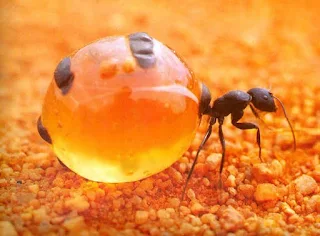 |
| Amabalabaswa |
 |
| Ewungabalosi |
3. Blood products
Blood was usually got from fat animals using a small bow and an arrow in a process called okhuchala. It was usually done at the neck. At times, blood was collected at the time of slaughtering. Fresh blood from an animal was called amalasire. It was then prepared into food called omuchalwa by stirring it vigorously using grass of the species of owukusinnde making it to clot into a thick stuff. (Human blood is amachayi and not amalasire). Amalasire was boiled to solid coagulates called engoliongo and eaten or mixed with vegetable. Sometimes blood was mixed with sour ash-milk and drunk as omuchalwa okwa omwembi. Blood from sheep was never used for this purpose. Also, animals being given as sacrifices had their blood not collected.
4. Edible big birds
Most of the grain and fruit eating birds were edible. The type of beak, past meal experiences after eating the bird and the bird's feeding habits helped in identifying edible birds. These birds included the following:
Edible smaller birds
Blood was usually got from fat animals using a small bow and an arrow in a process called okhuchala. It was usually done at the neck. At times, blood was collected at the time of slaughtering. Fresh blood from an animal was called amalasire. It was then prepared into food called omuchalwa by stirring it vigorously using grass of the species of owukusinnde making it to clot into a thick stuff. (Human blood is amachayi and not amalasire). Amalasire was boiled to solid coagulates called engoliongo and eaten or mixed with vegetable. Sometimes blood was mixed with sour ash-milk and drunk as omuchalwa okwa omwembi. Blood from sheep was never used for this purpose. Also, animals being given as sacrifices had their blood not collected.
4. Edible big birds
Most of the grain and fruit eating birds were edible. The type of beak, past meal experiences after eating the bird and the bird's feeding habits helped in identifying edible birds. These birds included the following:
- Amburuku

Amburuku - Ebongobongo- Olive pigeon
- Eito- Ostrich. Its meat was red. It was hunted using spears.

Eito - Ekhanga lya ekutusi- Crested guinea Fowl. They were slightly big and easy to hunt.
- Ekhanga lya esileesi- vulturine Guineafowl. Has nice tasting meat.

Ekhanga lya esilesi - Ekhanga lya olwika- helmeted guinea fowl. It has tasty white meat.
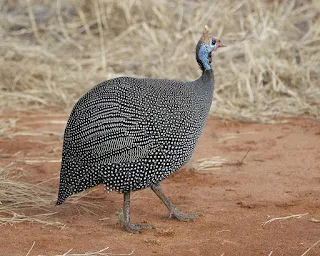
Ekhanga lya olwika - Ekhoocho- Cape Francolin. Usualy dark grey
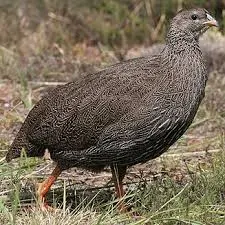
Ekhoocho - Ekhuyi ekhuyi- black stork. It was eaten roasted and never boiled. The entrails were carefully removed after sterving it for a day.

Ekhuyi khuyi - Ekhuyi Namayemba- white stock. Eaten roasted and never boiled. It was also sterved before roasting it.

Ekhuyi Namayemba - Ekulukulu- turkey

Ekulukulu - Endechia- Purple swamp hen.
- Eng'ang'a lya olwang'a- Glossy ibis. It produced black soup. It was roasted before cooking. The head, entrails and legs were not eaten.

Eng'ang'a - Eng'ang'a lya olupang'a- it had no shiny appearance and has a redish mouth with little hair on the head.

Eng'ang'a lya olupang'a - Engokho- chicken

Engokho - Engoye- Green starlin.
- Engisu- violet turnaco. Almost same to engusu in behaviour but lacking a crest on its head
- Engusu- great blue turaco (and many species of different colour- green, blue, white, black, yellow) Engusu had a crest on its head

Engusu - Eninga- African green pegeon. All birds that had similar structure and green colour feather were called eninga.

Eninga - Enyiru- red necked Francolin and Yellow necked Francolin. It had no feathers at its neck

Enyiru - Esichululu- The African quailfinch. It is a small bird similar to esindu. The whilte colour around the eyes makes it to look as if it has big eyes. This species, unlike the quails, can perch on trees easily.
- Esikasawa- Managua dove
- Esindu- this is the common quail. It does not love perchibg on trees. It was a delicacy that was given to female visitors as the male ate chicken. The male also ate it. Male one is called enyembi while the female one was called olunywenywe. Young female is called eseebe.
- Esindu eya khakhere- common bullonquail. It rarely flies; likes skulking on the ground. It was narrated that if you cover it with a basket, it turns into a frog. This was to desuade less skilled children in opening the basket in order to prevent it from escaping.
- Esikherekeke- name for both the red winged Francolin or crested Francolin.

Esikherekeke - Esisituka- loughing dove

Esisituka - Esitulienge- red bill hornbill.
- Ewusi- Cape turtle dove

Ewusi lya mungulu - Ewusi ekasaawa- Red eyed dove. It was a dove withred eyes and eyelids.
- Ewusi elya mumachi-sandgouse. They were of different varieties that liked walking near river sands, river stones and shallow waters.
- Ewusi lya khumwalo- African mourning dove. Always made its nest near rivers.
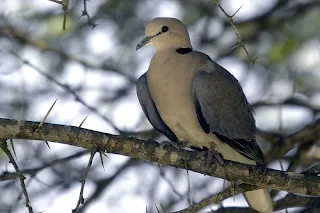
Ewusi lya khumachi - Ewusi elya mulukulu-
- Eyoyo- African black duck (and other species of ducks found in water streams.) A water duck called eyoyo ekhonge (spur winged goose) was said to cause sterility and was not eaten.

Eyoyo - Muchwe lupang'a- Black and white casked hornbill. Apart from its meat, the borne on its head was used to curve decorative wearings. Some of the same species were yellow beaked.
- Namwelirie- Southern Porchard
- Nanjekho- white/grey/bare faced go-away bird.

Nanjekho
Edible smaller birds
Most of the smaller birds were mostly hunted by children. They could be trapped and eaten.
- Akhayindikiri- Blue Tit
- Efurusi-
- Ekhoro
- Ekhunjwe- parrot.
- Emirye- Quelea
- Endikalikani- ban shallow
- Enyanyakhanu
- Engoye
- Enyereri- blabber
- Esesese- cane portrait.
- Esonjoli- woodpecker

Esonjoli - Esimbikhira- Long tail widow bird. Its feathers were used on kings hat. Its meat was believed to be good in ensuring there is peace, understanding and reconciliation when used in amasalule. Some believed it was key ingredient in making love potion if mixed with ash from a rope used by a person to commit suicide- other herbs. Its fethers together with those of esikhokhochole were believed to be a treasure for boys, leaders and businessmen. Some had fluffy long tails.

Esimbikhira - Esifu- speckled mouse bird

Esifu - Esifu eya khumachi- the blue naped mouse bird
- Esipangalisi
- Esoko elya amatekeyi- Black weaver bird.
- Esoko elya khulukongo- African golden weaver. It is golden yellow with few black elements.

Esoko - Esoko elya khumachi- streaked weaver . It has black wings or streaked wings or black face
- Epikolio elya khulukongo- juckobin coccoo. It yellow abdomen area

Epikolio - Epikolio lya khumachi- usually black.
- Etiatiasi- Great fiscal Shriek.
- Esebeyi- honey habinger bird.
- Kenge- nightngale. Another bird recognised as a singing bird among the Abanyala- to add on esoko, ekhunjwe, mutoli and kilumbe.
- Khalinjola- Lovebird
- Kilumbe- Malabar Whistling thrush
- Kiriyo-
- Malebe- bee eater meropidae

Malebe - Mulimba- malachite kingfisher. It made specific noise that was timed at one hour interval. The were varieties of mulimba that were not eaten such as Nafunioko.

Mulimba - Mutoli- mocking bird. It is among the birds with a nice singing melody.

Mutoli - Nakholo- white winged widows bird. This is usually confused with esichwinjwinchwi (pied wagtail). The bird attracts mates from birds of other species hence said to have no specific clan thus the name nakholo- it is ectra-clan polygamous. It has same behaviour with simbikhira.
- Nalufutu- Rainbow bird
- Nalukuku- sandpiper
- Namasa- black cackoo. Its major meals are warms, insects and caterpillars.
- Namungiri- African firefinch. This also included other soimilar birds that were yellow, blue, black, gre or brown.
- Namususuni- Sunbird and hummingbirds. Uncircumcised boys were desuaded from eating it for it was to believed to cause overbleeding at circumcision.

Namususuni - Nasing'aang'a- hornbill . This lacks the crest-like horn extension on the head.

Nasing'aang'a - Njwenjwe- lillark breasted roller. It was considered to be a very proud bird.

Njwenjwe - Ongunyi- grey wagtail. Very common at ploughing time.

Ongunyi - Opicha (swallow)- rarely perch on green twigs.

Opicha - Opichapicha- almost similar to opicha but bigger and wholly black.
- Otieto-
- Otundo
- Piri
- Piriupiru- wing snapping cistocola
- Sikorosia- blackcap

Sikorosia - Tietie- cristocolas cristicola
- Tindikiti
- Wachacha
7. Mamals meat and meat products
Some mamals were slaughtered or hunted for their meat. Bulls were castrated and the removed parts eatem by old men. The major souce of meat were:
Animals also produced fat which was stored to be used during cooking and as medicine. These animals were:
Some mamals were slaughtered or hunted for their meat. Bulls were castrated and the removed parts eatem by old men. The major souce of meat were:
- Akhakhisi- Dik Dak
- Eng'o mbe- cattle. It was major source of meat and blood.
- Ekondi- sheep. This is usually a source of meat after a traditional function. Sheep was never slaughtered for a mere visitor's visit. From it, people got the name Wamakondi.

Ekondi - Embusi- Goat. From it, people got the name Wambusi.

Embusi - Ekhisi- antelope. From it people got the name Wakhisi.

Ekhisi - Ekhulo- dear. From it, people got the name Makhulo.

Ekhulo - Emboko- buffalo. However, Abakwangwachi do not eat emboko. From it, we had people called Wamboko

Emboko - Embongo- gazzel. From it,we have men called Wambongo.

Embongo - Mwaka- aardvark.

Mwaka - Efuu- hippopotomus

Efuu - Enduyu- hare or rabbit

Enduyu - Embichi-wild pig

Embichi - Enjobe- waterbuck

Enjobe - Enjofu- elephant. From it, we have people called Wanjofu.

Enjofu - Ekhirikichi- rhino.

Ekhirikichi - Emuna- squirrel

Emuna - Esabale- poached rat. It smelled the hunters from afar. It had cheeks with wallet like lining and red legs. They were common in Musavale area near R. Nzoia in Navakholo.

Esabale - Emunje- cane rat. It was common in river reeds. It has rough furs and round ears. Some could be taken as pets trained to be sensitive to money. Once it nest was made of paper maney, then it got conditioned to the smell of mpney. They, it could sneak into people's houses, smell the money out and collect it to its nest.
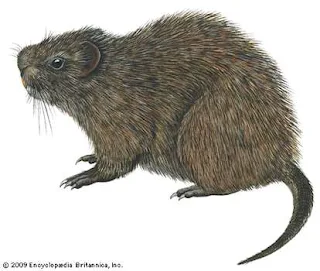
Emunje - Kanyuru- guinea pig

Kanyuru - Echungu- species of big rats (house rats were not eaten and are called embeba). The circumcision age set of 1952 is known by an additional tag of Abamachungu because there was hunger that made people to eat amachungu.
Animals also produced fat which was stored to be used during cooking and as medicine. These animals were:
- Sheep- the tail of a sheep calledcawas omusiembe was the main source. Female sheep were occasionally cut and prepared. The fatty tail was cut into small peces, let to fry in a pot until the pieces floated in oil. The oil was transfered into a storage container. The dried up peces romf which fat was removed were eaten or stired in honey for future eating. The stored fat was called omwayu.
- Cattle hump- hump meat had a lot of fat that was processed and stored stored for use. It was called amasalule malafu.
- Wild pig fat- used for wadding off evil spirits
- Lion's fat- When applied on body, it prevented attack by wild animals such as snakes, foxes, wild dogs, leopards etc
- Fish produced special medicinal fat for babies called olukhe
- Esabale- some deviated from cultural norms and domesticated esabale. They claim it had high intelligence service if trained. For example, some people usef them to identify items stolen from some homes. The skills involved wre same to Pavlov conditioning skill.
- Emunje- It could be trained to sense intrution from a distance. Recently, night runners could use them for the purpose of sensing any intrution in the environment. That a nightrunner could use it to sense if the owner of the home was waking up.
- Dogs
- Cats- they were key in eliminating snakes and rats.
- Oluwukawuka- there was specific call voice from this bird that signaled an enemy walking within the environment at night. Old men used its signal to catch thieves at night. If it made a neast near cow kraal, then it was total security siren.
























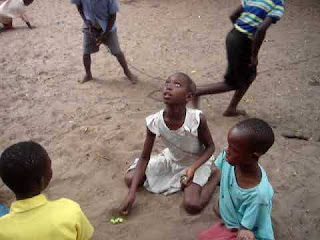
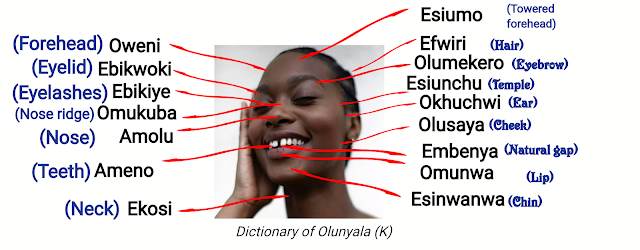
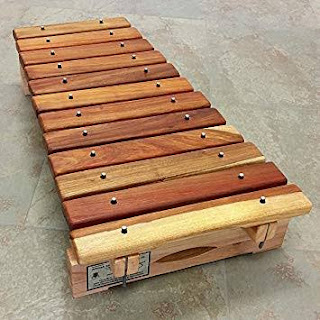
Comments
Post a Comment